北欧绿色邮报网报道(记者陈雪霏)–瑞典华人艺术家协会11月4日举办第二届冰雪音乐会。以下是精彩片段。音乐会由歌唱家邹荣美主持。
李佳演唱湖南花鼓戏《洗菜心》。
吴江燕演唱《贵妃醉酒》
京昆社演唱
朱瀛盈演唱游园
朱瀛盈和肖向平演唱惊梦
肖向平演唱拾画。
吴江燕和肖向平一起演唱幽媾。
瑞典华人合唱团联唱。陈丽娜演唱唱脸谱。
严红梅演唱《我家有个小九妹》。
马莲荣演唱评剧《报花名》。
王吉生曲亚萍演唱天仙配。
北欧绿色邮报网报道(记者陈雪霏)–瑞典华人艺术家协会11月4日举办第二届冰雪音乐会。以下是精彩片段。音乐会由歌唱家邹荣美主持。
李佳演唱湖南花鼓戏《洗菜心》。
吴江燕演唱《贵妃醉酒》
京昆社演唱
朱瀛盈演唱游园
朱瀛盈和肖向平演唱惊梦
肖向平演唱拾画。
吴江燕和肖向平一起演唱幽媾。
瑞典华人合唱团联唱。陈丽娜演唱唱脸谱。
严红梅演唱《我家有个小九妹》。
马莲荣演唱评剧《报花名》。
王吉生曲亚萍演唱天仙配。
北欧绿色邮报网报道-10月21日上午,以上海市政协办公厅副主任杨峥为团长的上海市政协友好访问团与瑞典上海联谊会在斯德哥尔摩举行座谈会。
上海市政协办公厅副主任杨峥说,他们访问瑞典的目的是更深入了解侨情,加强和所在地华人华侨,特别是上海籍华人华侨的沟通和联系。上海政协因此积极走出去,了解海外华人的生活, 促进侨乡华侨为祖国的发展发挥作用。
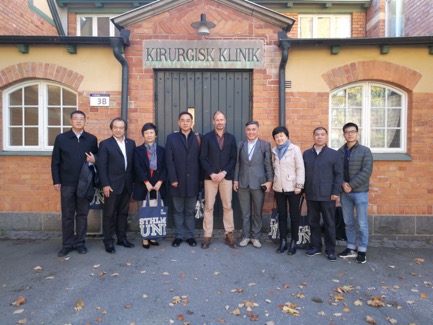 上海政协代表团成员:杨 峥 上海市政协办公厅副主任,代表团团长。乔国强 上海市政协委员,上海外国语大学英语学院教授,长江学者,博导,英美文学研究中心主任。
上海政协代表团成员:杨 峥 上海市政协办公厅副主任,代表团团长。乔国强 上海市政协委员,上海外国语大学英语学院教授,长江学者,博导,英美文学研究中心主任。
陈 鹏 上海市政协港澳台侨委员会办公室主任,舒同书法艺术研究会会长,中国艺术家协会上海书画院执行院长.
侯永刚博士 上海市政协研究室理论处处长。
李品才 上海市政协办公厅处长。
蔡瀛霄 上海市政协办公厅外事处科员,翻译。
上海政协办公厅副主任,代表团团长杨峥赠送具有上海特色的纪念品给瑞典上海联谊会,副会长兼秘书长谈继东代表接受了礼物。别具特色的礼品引出了我们的思乡的情怀,礼品盘里的画面涵盖了上海市的著名景点,东方明珠,金茂大厦,环球金融中心,上海中心,豫园,外滩建筑,滨江大道,世界博览会中国馆和白玉兰上海市市花等等。
出席座谈会的还有瑞典上海联谊会副会长鲍近,秘书长谈继东,财务总监王方正,候补理事叶滋匀和著名京昆剧表演艺术家吴江燕老师。
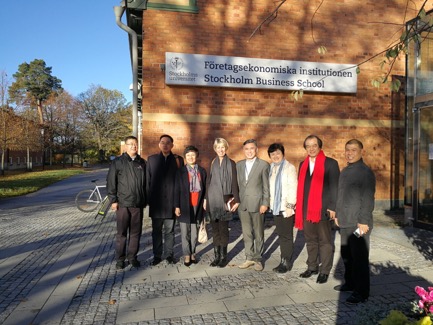 10月23日上午,代表团还参访了斯德哥尔摩大学商学院,房晓辉教授为代表团讲解了’跨文化创新模式的比较”。
10月23日上午,代表团还参访了斯德哥尔摩大学商学院,房晓辉教授为代表团讲解了’跨文化创新模式的比较”。
此前,代表团还在瑞典华人工商联合总会与华人华侨侨领举行了座谈会。
瑞典上海联谊会 谈继东供稿。
By Xuefei Chen Axelsson
STOCKHOLM, Nov. 1(Greenpost)–Kanas Scenic Spot is the most beautiful and spectacular scenic spot in Altay, in Xinjiang Uygor Autonomous Region and even in the world. Under the jurisdiction of Altay Prefecture, Northeasten part of Xinjiang, Kanas Scenic Spot is part of the nicknamed one thousand kilometer gallery.
It is an area of over 10 thousand square kilometers, receiving about 4.6 million tourists last year and is expected to receive 6 million by the end of this year. So far they have received 3 million. They plan to open the area to tourists from all over China and even the world. In the past the area was closed due to the heavy snow. Now tourism  have been prioritized as a pillar industry.
have been prioritized as a pillar industry.
Why is it so attractive and what is special with Kanas? Because it enjoys many only’s.
It is the only extension zone of Siberian taiga forests, the only distributed areas of Siberian animals and plants, the only Arctic water system nationwide in China, the only Mongolian Tuva habitation throughout the nation, the only scenic spot with European or Canadian style scenery(others dubbed it as Switzerland, but it is Kanas in Altay, Xinjiang ) in China and the only natural reserve that borders with another two countries across China.
 Kanas lake in the rain on Aug. 28, 2018. Photo by Xuefei Chen Axelsson.
Kanas lake in the rain on Aug. 28, 2018. Photo by Xuefei Chen Axelsson.
To promote tourism industry and facilitate infrastructure, starting from this year, Xinjiang adds 10 flight courses including Urumqi-Kanas, Turpan-Kanas tourism charter and the new train and bus routes inside and outside Xinjiang are constantly increasing as well.
A group of 15 foreign journalists from 14 countries including Japan, Sweden, Belgium, Afghanistan, Kyrgyzstan, Bangladesh, Indonesia, India, Egypt, Pakistan, Malaysia, Turkey and Uzbekistan and together with 22 Chinese journalists visited Kanas Lake and Kanas Pavillion. The beautiful scenery stunned everybody when they visited it.
We were told to take the PLA overcoat and umbrella with us because it will be very cold on the top of the hill. Most people did that except me. I thought as long as it is green, it should be tolerable.
As we climbed up to the top, it began to rain. Feeling like climbing the Mountain Tai in Shandong Province, East China, we also saw very beautiful white cloud covering the green trees and merging with the blue and green lake water.
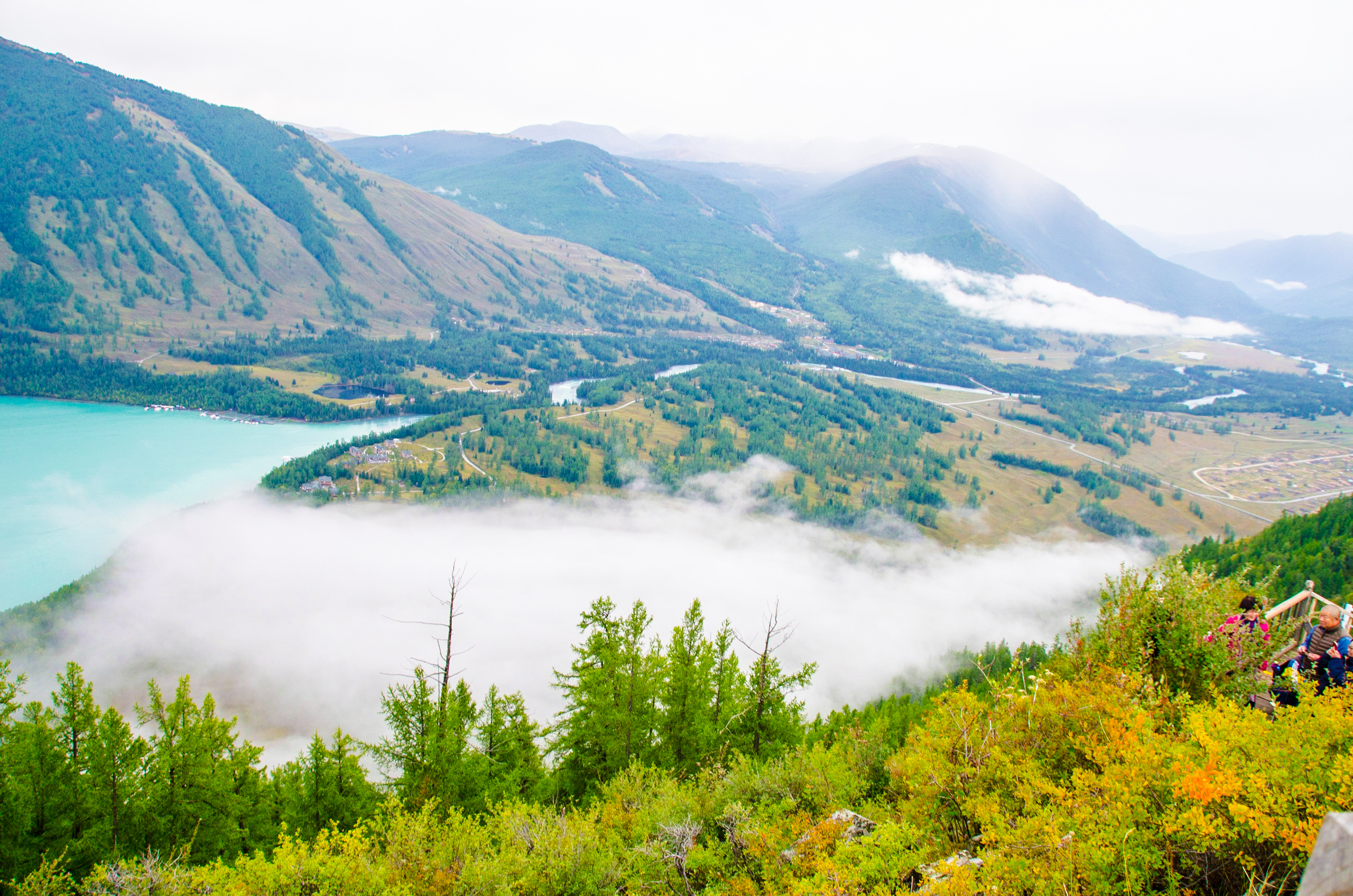 All the trees here are very green and fresh. All the bush under the trees are also beautiful because they showed different colors. Biodiversity is very obvious here.
All the trees here are very green and fresh. All the bush under the trees are also beautiful because they showed different colors. Biodiversity is very obvious here.
When we climbed to over 500 stairs, I thought we had passed two thirds of the stairs. Every movement up, we found a new angle to see the lake. It is green water. It looks like the lake in Calgary in Canada, I think, but it also looks like the gulf in Norway or the river in southern New Zealand and yet it is right here in Altay, China. It is just beautiful, clean and beautiful with the jade blue or creamy green. It feels like a treasure.
As we stepped up the steps, it rained even heavier. The white cloud didn’t disperse quickly. On the contrary, it emerged and extended to the lake. When the lake water almost covered by the white cloud, it looked so beautiful.
Tourists from Zhejiang province and Henan province or even Northeast China were walking in the rain. They all commended the place to be very beautiful and spectacular.
 When we arrived finally to the top by walking 1100 stairs, we came into the pavillion to have a good panorama view of the Kanas River or lake.
When we arrived finally to the top by walking 1100 stairs, we came into the pavillion to have a good panorama view of the Kanas River or lake.
The saying goes that one goes up to look at the lake and goes down to look at various flowers. One can described it as a sea of flowers with a great diversity.
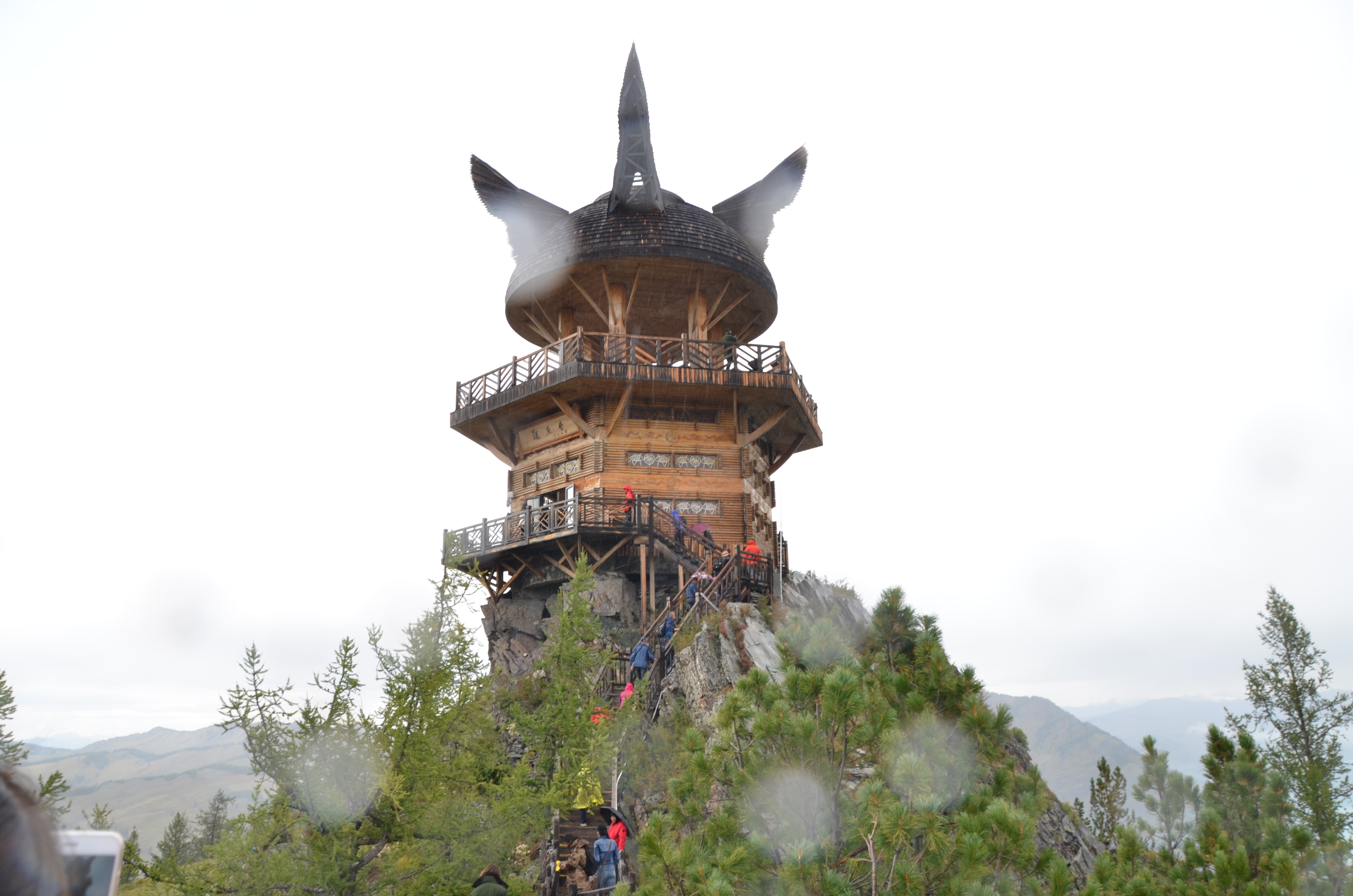 The pavillion is called the fish-watching platform.
The pavillion is called the fish-watching platform.
Then one went down. It was just so beautiful. It was such a joy to have this trip because it is so clean.
Kanas Lake is famous also for changing colour with seasons and weather change in spring, summer and autumn. The water color is actually steel grey in May, light green or bright green in June, milky white with slight blue and green in July, dark green in August, and emerald in September and October. From November to next April, it is the icing period, when the whole Kanas Lake becomes a silver white world, the color still changes due to sunny or cloudy days and to high or low clouds.
 In the afternoon, the journalists took a sightseeing boat floating on the lake. They experienced the beautiful water scenery and took a lot of photos.
In the afternoon, the journalists took a sightseeing boat floating on the lake. They experienced the beautiful water scenery and took a lot of photos.
Kanas lake with a history of about 200 thousand years is like a crescent,with the altitude of 1.374 meter, 24.5 kilometer long, 2.2 km wide maximum, 1.87 kM wide and the depth is 120 meters on average. and 197 meter deep maximum. Boasting an area of 45.78 km2, the lake has a storage capacity of 5.4 billion cubic meters , equivalent to 4 cubic meter for each of the 1.3 billion people in China. It is also the deepest freshwater lake in China.
The fairy tales about water monster are spread here among the people, it is suspected that there are huge fish in this lake to welcome the people.
 Kanas Lake, in the middle-mountain forest belt at the southern foot of Altay Mountains, is a loop moraine barrier lake through glacial scour in the quaternary ice age. Huge glacier covered Altay Mountains and then slid downward along the mountain terrain due to its gravity. During the process, the glacier bottom and the massif has strong friction and caused extrusion, transportation and digging, then the front end of the glacier melted gradually, the meltwater discharged downward, and tills accumulated in large quantities at the mouth of Kanas Lake, forming a loop moraine of about one kilometer wide and 50-70 meter high, which barred the valley, where meltwater from glacier and snow collected year after year to gradually form the beautiful Kanas Lake today.
Kanas Lake, in the middle-mountain forest belt at the southern foot of Altay Mountains, is a loop moraine barrier lake through glacial scour in the quaternary ice age. Huge glacier covered Altay Mountains and then slid downward along the mountain terrain due to its gravity. During the process, the glacier bottom and the massif has strong friction and caused extrusion, transportation and digging, then the front end of the glacier melted gradually, the meltwater discharged downward, and tills accumulated in large quantities at the mouth of Kanas Lake, forming a loop moraine of about one kilometer wide and 50-70 meter high, which barred the valley, where meltwater from glacier and snow collected year after year to gradually form the beautiful Kanas Lake today.
Sleeping one night in Friendship Peak in Buerqin, we headed for Yuehu Hotel to see the Kanas Lake.
Kanas Lake, deep in Altay mountains is within the scope of Kanas River basin, with the supplementary water mainly by melt water from the Friendship Peak and the Kuitun Peak, Altay Mountains and precipitation over the lake area. Kanas River with its rise in the Kanas Glacier at the Friendship Peak, the highest peak of Altay Mountains, 125 km long in total, flows from the northeast to the soutnwest and meets Hemu River at Jiadengyu to become Buerqin River, which finally goes into Irtysh River.
Kanas Lake is the core and cream of the state-level Kanas Nature Reserve, and a highlight of nature, where the natural ecological environment remains primitive with mountains embracing in manner of layer upon layer, dense forest, lush meadow, clear water, blue sky, green mountains, white clouds, snow-covered peaks, and grassy marshlands…all in an integral whole, and all too beautiful to be absorbed completely at once.
After seeing the Kanas lake, the journalists visited Zhalat Tourism Cooperative. Zhalat Tourism Cooperative was established by Yerkebatu, a villager of Kanas Village in April 2015. It is the first one of its kind led and founded by village-level party organization, with the registered capital of 535 thousand yuan or about 80 thousand US dollars.
A beautiful Tuwa woman Ouchun welcomed the journalists to a wedding room first. She explained that the wedding room is a pure wooden house without any spike. The house was built with tree trunk. And they put moss into the rift between wood blocks. Ouchun explained that this was the traditional way of building tree house and the moss will become shrinking in winter and blossom in summer. They also put liquid of pine trees into the wood.
Ouchun said all the quilts, mattress and furnature are made by themselves. In the family exhibition room, they hold a photo of the PLA doctors came to them to treat the patients and the people here participate national skiing meeting in 1958.
 Ouchun said the most special thing for this cooperative is to make the skin skiing board. They will help to go up the hill easily to prevent backward falling and go down faster.
Ouchun said the most special thing for this cooperative is to make the skin skiing board. They will help to go up the hill easily to prevent backward falling and go down faster.
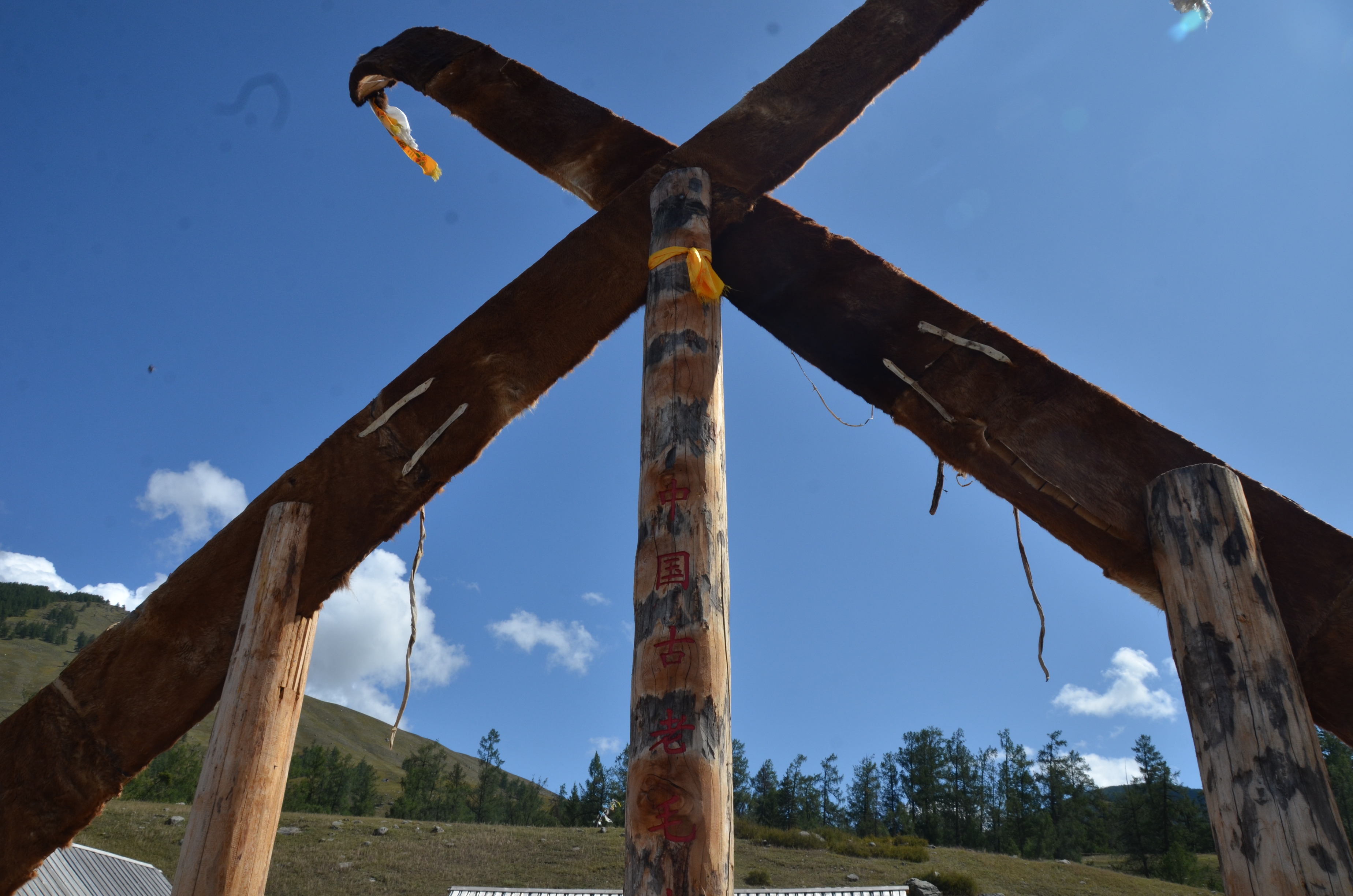 The family has about 20 members and they have 12 rooms. The whole cooperative has 25 rooms with the construction area of 800 square meters and 8 artists to exhibit and sell more than 100 kinds of products and present shows of songs and dances.
The family has about 20 members and they have 12 rooms. The whole cooperative has 25 rooms with the construction area of 800 square meters and 8 artists to exhibit and sell more than 100 kinds of products and present shows of songs and dances.
In 2017, the Cooperative realized operating income of 500 thousand yuan . It has attracted 50 thousand tourists accumulatively.
The ecological house style is Mongolian Tuwa style, but also very similar to the Swedish style.
 Ouchun said it is estimated that there are only 2000 Tuwa people whose ancester was Mongolians. They have developed more and more tourism now. But they also rely on animal husbandry.
Ouchun said it is estimated that there are only 2000 Tuwa people whose ancester was Mongolians. They have developed more and more tourism now. But they also rely on animal husbandry.
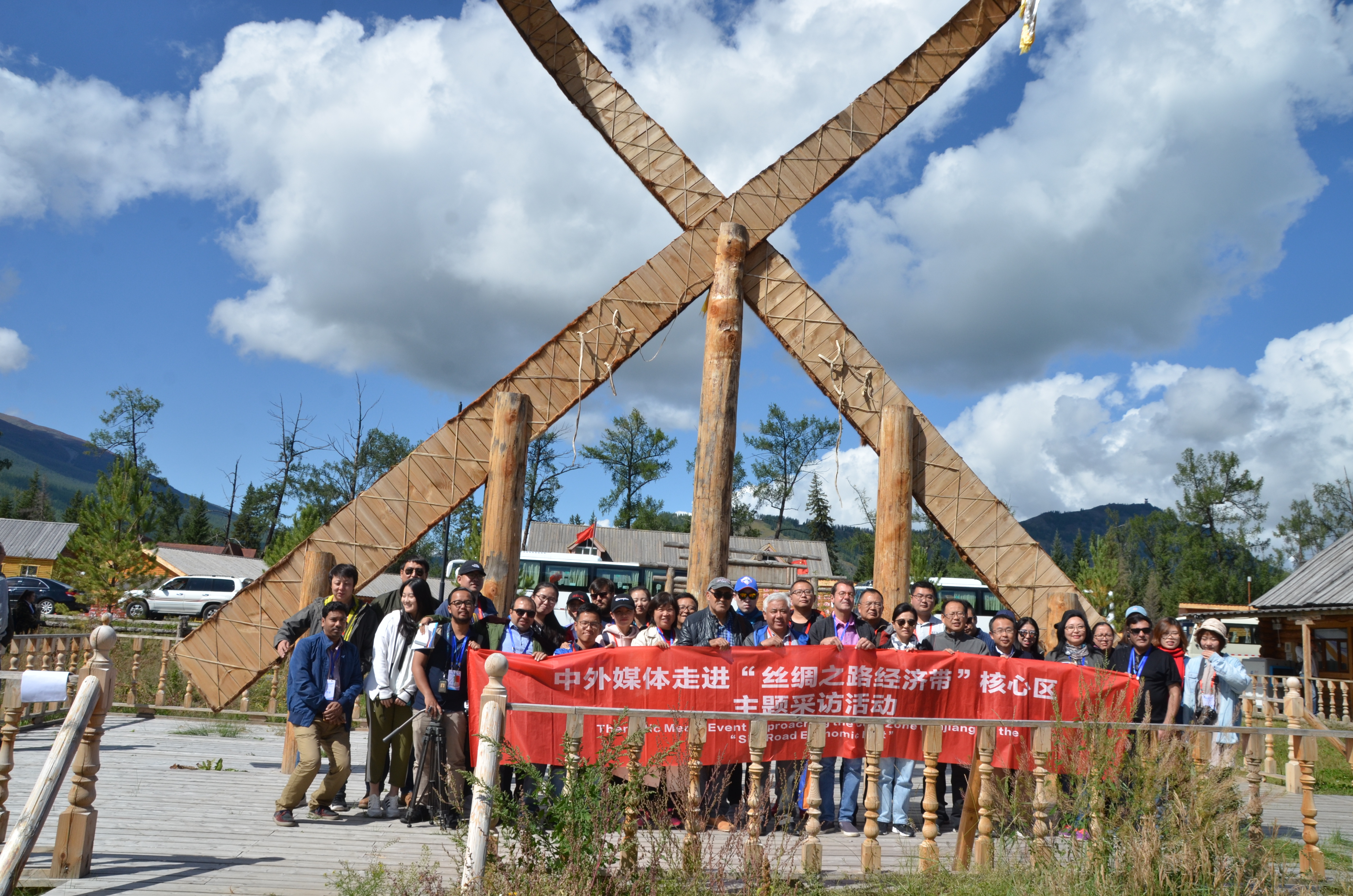 Finally, all the journalists entered into a Mongolian style dome house and listened to the artists performance.
Finally, all the journalists entered into a Mongolian style dome house and listened to the artists performance.
The cooperative is market oriented takes original – ecology culture as the priority, centers on original- ecology culture experience products, enhances its business through sales of cultural tourist products and highlights group tourists led by tour guide while attracting self-help tourists, to build the brand of original – ecology culture experience.
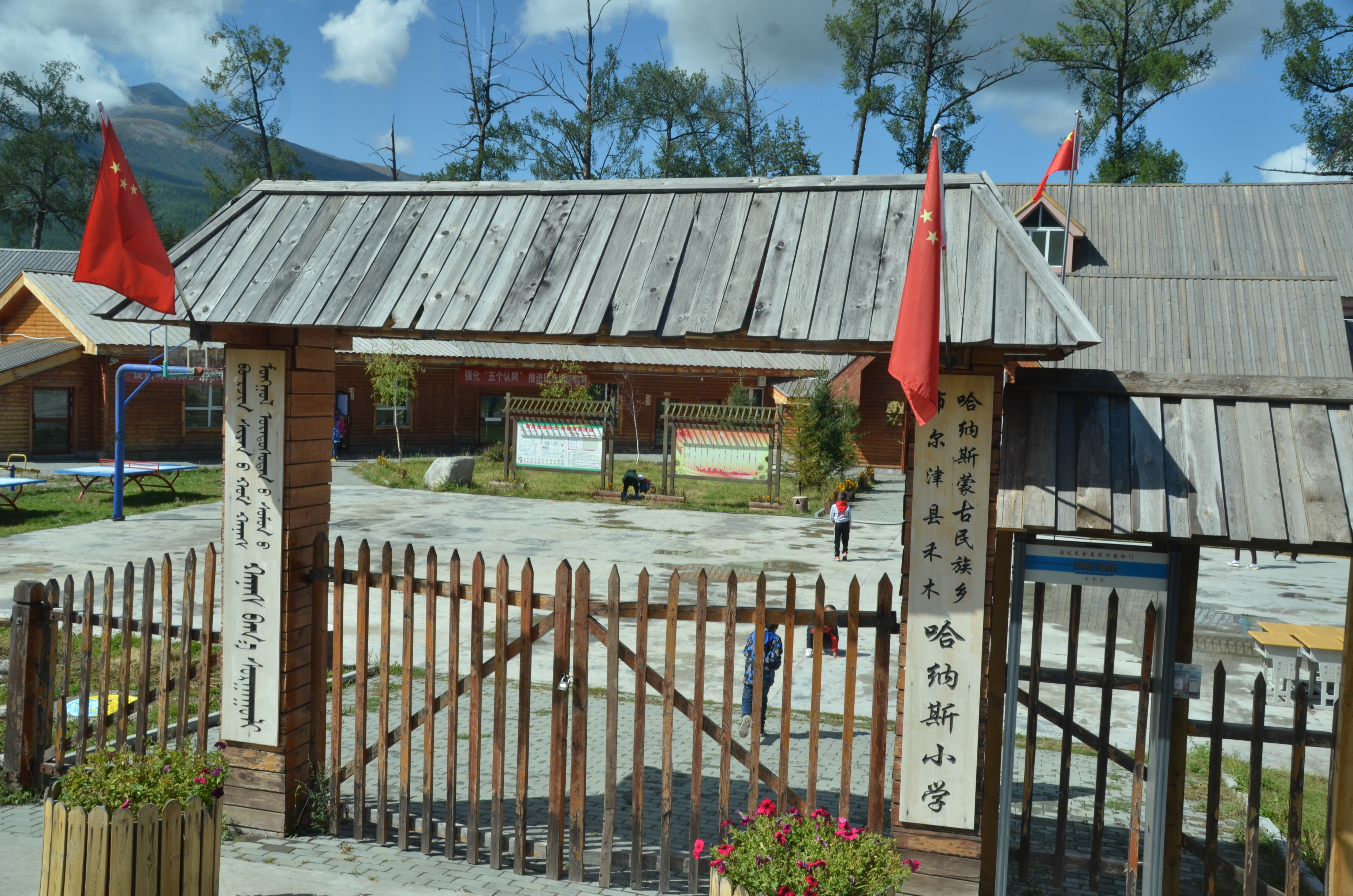 They have a primary school here with 100 pupils. When they go to middle school, they will go to the county to have boarding school.
They have a primary school here with 100 pupils. When they go to middle school, they will go to the county to have boarding school.
The artists performance were wonderful and with welcoming wine ceremony people also observed how people made milk wine.
After this trip, people went back to the Yuehu Lake Hotel and had lunch. The lunch was delicious because it had a good variety of food.
In the afternoon, the journalists went through the fairy bay of the Kanas River.
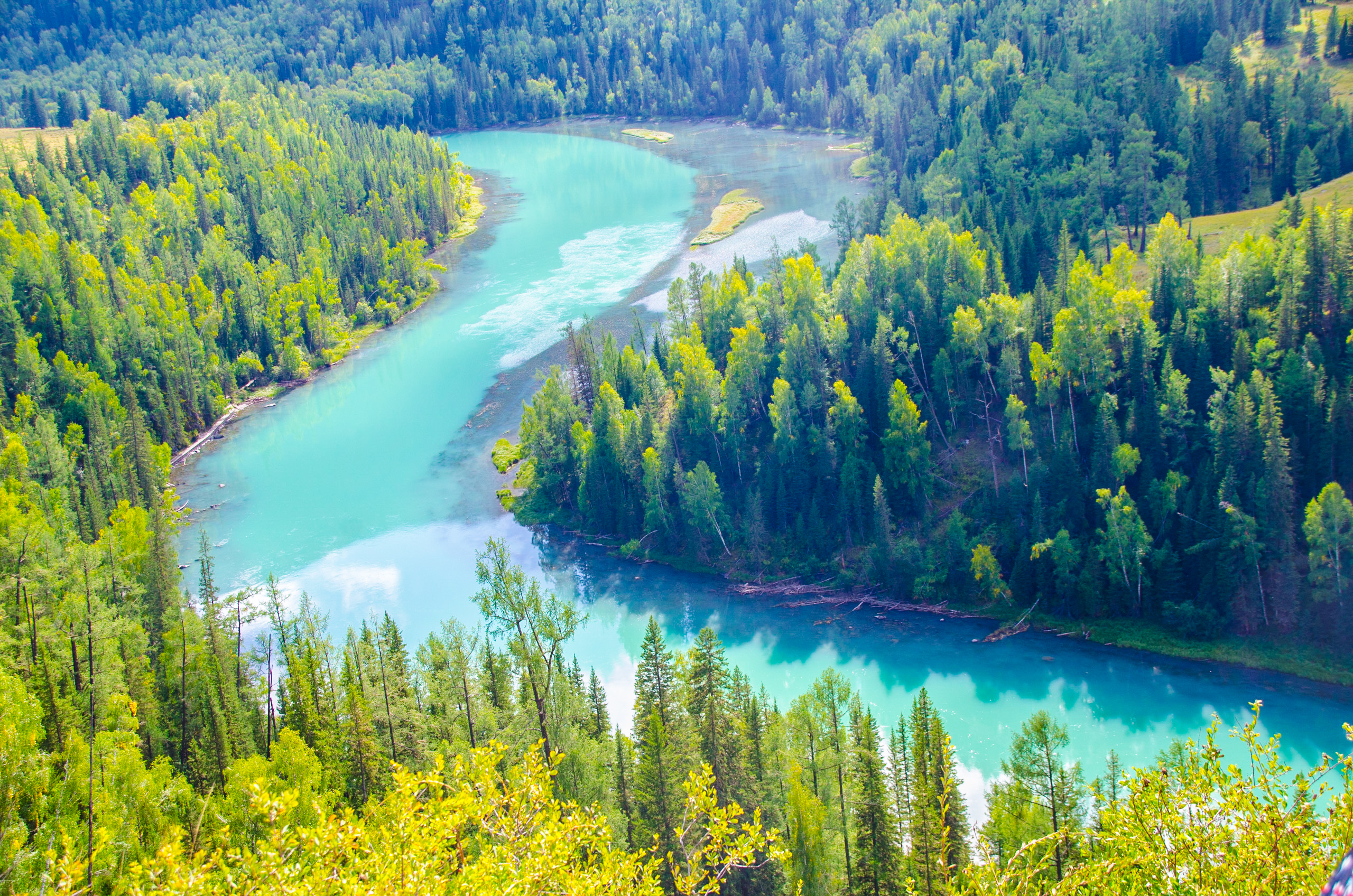 Then they stopped in the Moon Bay before they came to the lying dinasour bay.
Then they stopped in the Moon Bay before they came to the lying dinasour bay.
By the end of the day, they arrived in Hemu Hotel with Swedish wooden house style.
The tree trunk here is far better than that in the cooperative. This is such a high level hotel which is very customer friendly. Outside in the yard, there are all kinds of plants and flowers. Canal streams flow naturally with fishes swimming in it. It is such a beautiful place.
All these natural resources with huge investment from the government and the priority on tourism make the local herdmen benefit a lot in recent years.
The theme of this trip was to visit the tourist sites themed on Silk Road Economic Belt. It’s obvious that the Chinese government has invested heavily in Xinjiang’s Altay prefecture and support the local policy of putting ecological construction on priority and realized the green development.
The local leaders clearly remembered President Xi Jinping’s idea of Green mountains and rivers are actually the gold and silver mountains.
By Xuefei Chen Axelsson.
By Xuefei Chen Axelsson
STOCKHOLM, Oct. 23(Greenpost) — On the morning of August 28th, Green Post reporter went together with the Chinese and foreign journalist group to the colorful beach in Burqin County, Xinjiang’s No.1 Beach.
On that day, the weather was fine and the sky was clear. The three big sheep in front of the colorful beaches left a deep impression.
Going inside, the first thing that comes into view is the two galloping horses. This is one of the few artificial art.
The reason why the colorful beach is special is because it has a desert scenery, a desert climate and plants, a strange Yadan landform, a river flowing into the Arctic Ocean and an indomitable Populus euphratica.
The word Yadan is actually the name given by the famous Swedish explorer Sven Heding. It refers to the landscape that is subject to wind erosion. It is very fragile and cannot be trampled, but it is very strange. The shapes can be left to people’s imagination. The Yadan landform, or Yardang, is a typical wind erosion landform. “Yadan” means “a hill with a steep wall” in Uyghur. Due to the abrasive effect of the wind, the lower part of the hill is often subjected to strong denudation and gradually forms a concave shape. If the rock formation in the upper part of the hill is relatively loose, it will easily collapse under the action of gravity to form a steep wall, forming a Yadan landform. Some of the landforms look like ancient castles, commonly known as the Devil City. The famous Devil City Scenic Area is located in the World Devil City Scenic Area in the Urhe District of Karamay City. It is understood that the Yadan landform has only been formed for more than 250 years.
The landform of the colorful beach is so colorful. Red, yellow, green and white are available.
Sometimes you will feel like a lion or a tiger, and sometimes you will have the image of a small animal.
The river here is called the Irtysh River and is more than 4,000 kilometers long. It is the only water system in China that flows to the Arctic Ocean. According to the tour guide, the river flows northwest, just the opposite of all other rivers in China. The fish in the river is called a pike, a fish that eats fish. This year, the climate is relatively dry, so there is a small island like a turtle in the middle. When the amount of water is large, it will be submerged. The river is almost never frozen because it is a flowing river.
Another landscape of the colorful beach is wind power. Wind power does not belong to tourist attractions, but it gives visitors another view. The two companies don’t talk about it, but when they look together, they are so harmonious and beautiful. Wind power is a clean energy source. Just in line with the concept of ecological civilization.
Liu Qiang, head of the colorful beach scenic spot in Burqin County, said that the plant is called a camel thorn, mainly grown in the Gobi Desert. He said that the colorful beaches showed different colors according to the different angles of the sun’s refraction. Its four-star tourist attraction has attracted 300,000 visitors this year. They hope to attract 500,000 visitors by the end of the year. This scenic spot is still under construction. In the future, electronic interpretation equipment will be provided, sculptures will be set up, local customs will be introduced, and more public toilets will be established.
Ye Suqin, director of the Burqin County Tourism Bureau, said that this year, the tourism industry in Burqin County is expected to attract 5 million tourists. The development of the global tourism industry has driven the development of related industries. Tourism has accounted for 42% of the national economy. The tourism-driven employment rate accounts for 35% of the total employment rate. Taxes account for 16%. Per capita tourism income accounts for 35% of total income. This is also evidence of the Burqin County tourism brand. They built this as a five-A scenic spot. Realizing the integration of property rights, the integration of tourism city and the integration of people and scenery, is Jingmei, people are more beautiful, the whole city is a scenic spot, everyone is a tourism ambassador, she said.
The dead tree crown is also a manifestation of biodiversity, it may produce aphids to attract birds!
It is yellowish here.
Here it is purple!
Here is a hole!
All kinds of wonders and colorful colors coexist harmoniously to form a beautiful picture.
Look at this landform, as if it were a terracotta warrior, and it seems to be thousand horses. It is shocking.
The foreign media participating in this reporting trip include NHK from Japan, Nordic Green Post Network of Sweden, Echo News of Belgium, Toro News of Afghanistan, Gikabar National News Agency of Kyrgyzstan, media from Bangladesh, NET TV of Indonesia, and journalists from India, Egypt, Pakistan, Malaysia, Turkey and Uzbekistan. They are journalists from countries along the Silk Road Economic Belt and come to explore the mysteries of the core area of the Silk Road Economic Belt in Xinjiang Uyghor Autonomous Region.
Photo and Text Chen Xuefei
Av Xuefei Chen Axelsson
STOCKHOLM, 23 oktober (Greenpost) – På morgonen den 28 augusti gick Green Post reporter tillsammans med den kinesiska och utländska journalisten till den färgstarka stranden i Burqin County, Xinjiangs No.1 Beach.
På den dagen var vädret fint och himlen var klar. De tre stora fåren framför de färgstarka stränderna lämnade ett djupt intryck.
Att gå in, det första som kommer fram är de två galoppande hästarna. Detta är en av få konstgjorda konst.
Anledningen till att den färgglada stranden är speciell är att den har ett ökenlandskap, ett ökenklimat och växter, en märklig Yadan landform, en flod som strömmar in i Arktis och en oförstörbar Populus euphratica.
Ordet Yadan är faktiskt namnet som ges av den berömda svenska utforskaren Sven Heding. Det hänvisar till landskapet som är utsatt för vindosion. Det är väldigt bräckligt och kan inte trampas, men det är väldigt konstigt. Formerna kan lämnas till människans fantasi. Yadan landformen, eller Yardang, är en typisk vindosion landform. “Yadan” betyder “en kulle med en brant vägg” i Uyghur. På grund av vindens slipande effekt utsätts den undre delen av kullen ofta för stark utmattning och bildar gradvis en konkav form. Om bergformationen i den övre delen av kullen är relativt lös, kommer den lätt att kollapsa under gravitationens verkan för att bilda en brant vägg som bildar en Yadan landform. Några av landformarna ser ut som gamla slott, allmänt känt som Devil City. Den berömda Devil City Scenic Area ligger i World Devil City Scenic Area i Urhe District of Karamay City. Det är underförstått att Yadan landformen endast har bildats i mer än 250 år.
Landskapet på den färgglada stranden är så färgstark. Röd, gul, grön och vit är tillgängliga.
Ibland kommer du att känna dig som en lejon eller en tiger, och ibland kommer du att få bilden av ett litet djur.
Floden här kallas Irtyshfloden och är mer än 4000 kilometer lång. Det är det enda vattensystemet i Kina som flyter till Arktis. Enligt reseguiden strömmar floden nordväst, precis motsatt av alla andra floder i Kina. Fisken i floden kallas en gädda, en fisk som äter fisk. I år är klimatet relativt torrt, så det finns en liten ö som en sköldpadda i mitten. När mängden vatten är stor kommer den att sänkas. Floden är nästan aldrig fryst eftersom det är en flödande flod.
Ett annat landskap av den färgstarka stranden är vindkraft. Vindkraft är inte tillhörande turistattraktioner, men det ger besökare en annan utsikt. De två företagen pratar inte om det, men när de ser tillsammans är de så harmoniska och vackra. Vindkraft är en ren energikälla. Precis i linje med begreppet ekologisk civilisation.
Liu Qiang, chef för den färgstarka stranden sceniska platsen i Burqin County, sade att växten kallas en kameltorn, främst odlad i Gobi-öknen. Han sa att de färgstarka stränderna visade olika färger enligt olika vinklar av solens brytning. Dess fyrastjärniga turistattraktion har lockat 300 000 besökare i år. De hoppas kunna locka 500 000 besökare i slutet av året. Denna natursköna plats är fortfarande under uppbyggnad. I framtiden kommer elektronisk tolkning utrustning att tillhandahållas, skulpturer kommer att inrättas, lokala tullar kommer att introduceras, och fler offentliga toaletter kommer att inrättas.
Ye Suqin, chef för Burqin County Tourism Bureau, sade att detta år turism industrin i Burqin County förväntas locka 5 miljoner turister. Utvecklingen av den globala turistindustrin har drivit utvecklingen av närstående industrier. Turismen har utgjort 42% av den nationella ekonomin. Den turismdrivna sysselsättningsgraden står för 35% av den totala sysselsättningsgraden. Skatter står för 16%. Turistinkomst per capita står för 35% av den totala inkomsten. Detta är också bevis på Burqin County turism varumärke. De byggde detta som en fem-A scenisk plats. Att realisera integrationen av äganderätten, integrationen av turismstaden och integrationen av människor och landskap, är Jingmei, människor är vackrare, hela staden är en vacker plats, alla är en turismambassadör, sa hon.
Den döda trädkronan är också en manifestation av biologisk mångfald, det kan producera bladlöss för att locka fåglar!
Det är gulaktigt här.
Här är det lila!
Här är ett hål!
Alla slags underverk och färgglada färger samverkar harmoniskt för att bilda en vacker bild.
Titta på denna landform, som om det var en terrakottakrigare, och det verkar vara tusen hästar. Det är chockerande. De utländska medier som deltar i denna rapporteringsresa inkluderar NHK från Japan, Nordic Green Post Network of Sweden, Echo News of Belgium, Toro News of Afghanistan, Gikabar National News Agency i Kirgizistan, media från Bangladesh, NET TV i Indonesien och journalister från Indien , Egypten, Pakistan, Malaysia, Turkiet och Usbekistan. De är journalister från länder längs Silk Road Economic Belt och kommer att utforska mysterierna kring kärnområdet i Silk Road Economic Belt i Xinjiang Uyghor Autonomous Region.
Foto och text Chen Xuefei
By Xuefei Chen Axelsson
STOCKHOLM, Oct. 23 (Greenpost) — In the afternoon of August 27th, the reporters went to Gaubau Kender base town of Burqin County in the Altay region with the interview team of the Silk Road Economic Belt in the Altay area.
Along the way, through the window, people can see many of the posters of General Secretary Xi Jinping and various ethnic minorities. The caption is that Xijinping and Xinjiang people are hand in hand and heart by heart.
When the bus drove to the Gebao plant base, a beautiful scenery appeared in front of the reporter. Here is the endless growth base of Gebao. In a row, a strain of Ge Bao is planted according to the guidance of scientists and according to a certain plant spacing and line spacing.
So what is Ge Bao Ma, what is its use? It is understood that Gebao kenaf is a new variant of Apocynum venetum. Apocynum venetum was the late agricultural economist Dong Zhengjun who conducted an agricultural research in the Luobu Plain in Xinjiang in the summer of 1952. It was found that the local wild hemp grew particularly vigorously and the fiber quality was particularly excellent. At the same time, in view of the fact that the Chinese people’s food and clothing have not yet been resolved, under the social background and material conditions at that time, the implementation of the oleander red and white wild hemp in all parts of the country is called apocynum, which is conducive to the industrialization of the promotion and settlement of cotton grain land acquisition and growing. The fiber needs can play a considerable role, this is the original intention of Apocynum ye named by Mr. Dong Zhengjun. However, unfortunately, due to human destruction, climate deterioration and other reasons, Apocynum venetum has not been artificially planted according to the wishes of Mr. Dong Zhengjun, and suffered a large number of arsenic farming. Hasty success and disorderly development resulted that the kenaf was on the verge of extinction, and the quantity and quality of white linen has dropped dramatically.
Luobu or Rob kenaf, in the Tang Dynasty “new revision of the grass” book, and the Ming Dynasty “salvation of the grass”book called “ze paint”, the modern “Chinese higher plants” called “tea flower.” In 1977, Rob kenaf and Robb white were officially entered into “Chinese Flora”, and Apocynum venetum Linn (Apocynum venetum Linn) was designated as Apocynum venetum L. In the same year, Rob kenaf was recorded in the Pharmacopoeia of the People’s Republic of China, and the total flavonoids of the iconic ingredients were 0.6%. Gebao red hemp is a treasure, hemp seeds can be made into tea, stems and leaves can be made into fiber, and become the material of underwear. It can also make the Gobi Desert greener.
From 123 mu(8.2hectare) to 30,000 mu(2000 hectare)
Originally, Liu Qitang (Liu Ban Ge), the chairman of Huatian Textile Fashion (Hong Kong) Co., Ltd., decided to become attached to Apocynum yepa in order to realize his dreamed life. Since 2002, together with China’s famous experts in wild plants, grassland ecology, remote sensing measurement, Chinese medicine chemistry and other areas related to Apocynum venetum, the research team have been in the Yellow River Basin, Hexi Corridor, Qaidam, Tarim reserves and values of 29 apocynum historical distribution areas such as Zhun Geer were repeatedly investigated and evaluated. It was found that it is located at 87 degrees in Tokyo, 47 degrees north latitude, and the northernmost part of the world is the farthest from the coast. Altay’s Alahaq East Gobi still has 123 acres of apocynum. Due to the special temperature difference, wind and light, heat and water, the plant produces more active ingredients related to stress resistance, and is different in morphology from apocynum growing in other areas, which has attracted the attention of authoritative experts.
According to the national qualification agency, the average effective brass content of the plant was 2.38%. It was researched by Xiao Zhengchun, the director of the former Chinese Apocynum Research Center, and Zhang Weiming, a researcher at the Nanjing Wild Plant Comprehensive Utilization Research Institute, and the internationally renowned plant taxonomy Professor Li Bingtao. They all hailed this plant as “Gobi Treasure” and named it Altay Gebao Apocynum Venetum Red.
In order to save Gebao kenaf, since 2007, Gebao Company has artificially planted 26,000 mu(1800hectare) of Gebao kenaf for over 10 years time, accounting for 90% of the total amount of Chinese kenaf. In 2012, Beijing Forestry University conducted an ecological environment assessment.
The results showed that the community was highly quadrupled, the vegetation carbon storage increased by 4 times, the soil microbial biomass increased by 76%, and the water use efficiency increased by 60%. The soil wind erosion modulus is reduced by 80%. The planting of Gebao kenaf can greatly improve the ability of the Gobi desert to prevent wind and sand. Let alone, the top fruit of the Gebao plant can be drunk as tea.
I saw a lot of sea buckthorn trees in the General Mountain. The seabuckthorn tree can be said to be a kind of green tree that grows against driness. The Gebao kenaf is a good way to transform the Gobi Desert into grassland.
In 2012, in order to save the ecological environment of Lake Aibi, based on the successful implementation of the rescue project of Gebao kenaf in Altay, the desert-changing oasis project, with the invitation by Jinghe County People’s Government, the Aibi Lake Wetland National Nature Reserve Administration, Gebao Group jointly implemented the first phase of the Aibi Lake project and planted 100,000 mu(6667hectare)of Gebao plants.
After 10 years of biomimetic planting, the area was rated as the 3A tourist attraction of Altay Gebao sea of flowers in Xinjiang, which was based on the Gebao kenaf eco-industry, featuring Gobo kenaf tea to improve sleep, and integrating Chinese medicine to maintain health. Folklore show, leisure vacation, sightseeing tour, science experience are all gathered in one eco-tourism circle.
Standing on the GI tower with 123 steps to save the gems and pebbles, you can feel their enthusiasm to welcome visitors from all over the world.
According to reports, the Gebao kenaf project has great practical significance. First of all, it is a successful case of preventing desertification. Here is the ideal to turn the Gobi into an oasis. Among them, Gebao Company invested a lot of money, manpower and material resources. At the same time, many scientists and academicians participated in it, and through scientific research, the Gobi became an oasis and expanded the lake area.
Second, Gebao kenaf is also a kind of traditional Chinese medicine. It is said that Gebao kenaf health care products can improve people’s health. According to China Center for Disease Control, China has more than 300 million patients, and more than 200 million people have cardiovascular and cerebrovascular diseases. On average, one person dies of cardiovascular and cerebrovascular diseases every 30 seconds, and one third of healthy people have sleep obstacles, resulting in a sub-healthy population as high as 76%. Gebao kenaf can be a natural health food for people with high blood pressure, high blood fat and sleep disorders.
Liu Qitang’s daughter Liu Xiaoyu told reporters that this project was his father’s hard work. After many years of long search, he finally found Rob kenaf. Then they carried out large-scale artificial planting of Rob kenaf and realized 30,000 mu(2000 hectare) of green grassland. They also plan to plant another 50,000 mu(3333 hectare) and turn the Gobi Desert into an oasis.
The nearby lake water level used to decrease. but after more than 10 years of remediation and greening, the surface of the lake has expanded. It can be seen that artificial planting can achieve environmental improvement. At the same time, Gebao kenaf can develop derivative industries while controlling desertification, and establish a demonstration for the transformation of local traditional agriculture and animal husbandry. It has directly increased the income of farmers and herdsmen and improved their cultural quality, achieved sustainable economic development. The construction of ecological civilization is a national strategy, and the Gebao kenaf project truly reflects the concept of green mountain is also golden mountain. Gebao kenaf products include food, tea, health underwear, socks, hats and other clothes products.
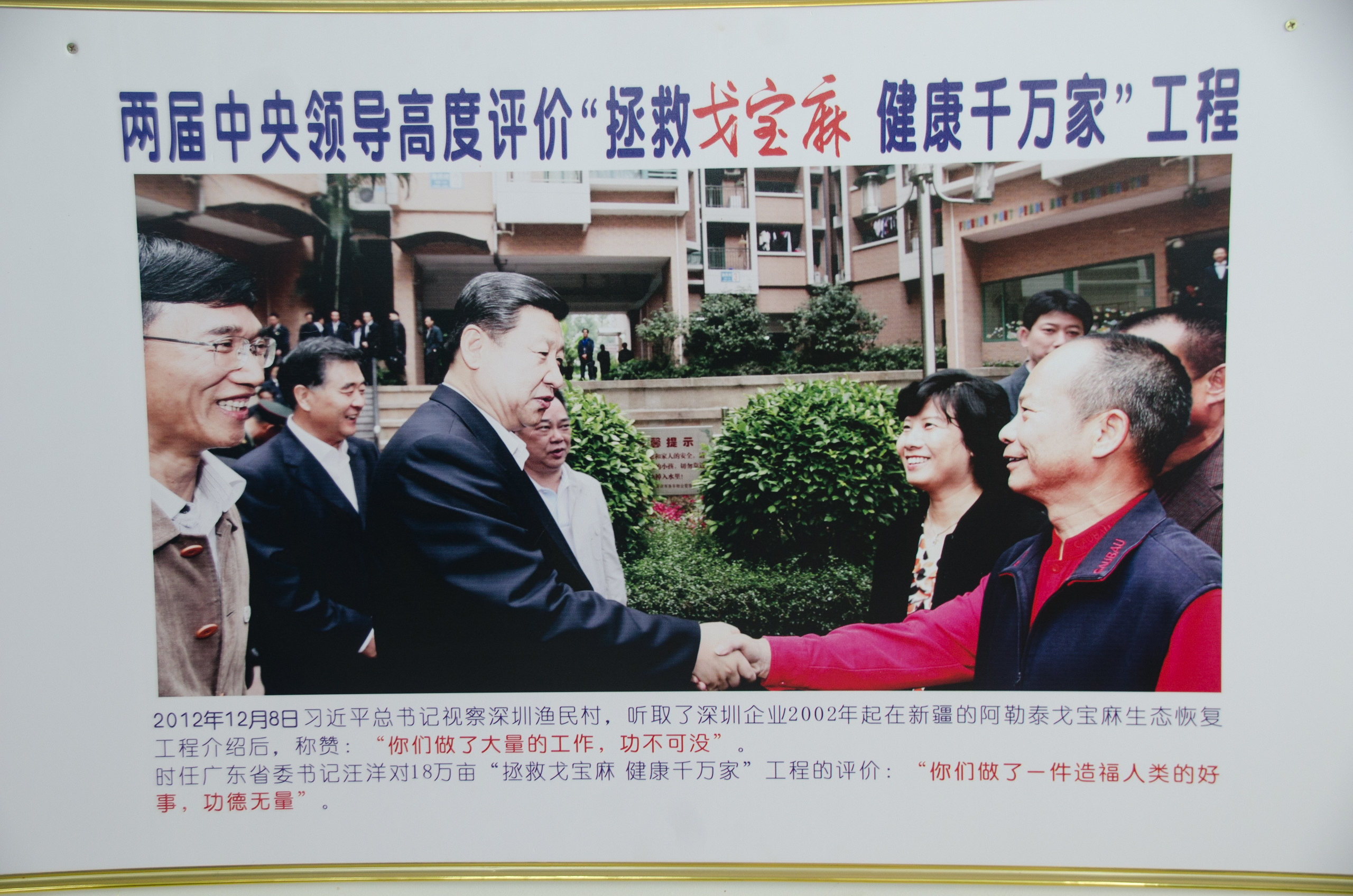 President Hu Jintao and Xi Jinping listened to the introduction of the ecological restoration project of Xinjiang Altay Gebao kenaf in 2010 and 2012 respectively.
President Hu Jintao and Xi Jinping listened to the introduction of the ecological restoration project of Xinjiang Altay Gebao kenaf in 2010 and 2012 respectively.
In 2012, the United Nations Peace Ambassador, international piano superstar Lang Lang and Gebao Group CEO Liu Qitang based on the common environmental protection concept, gave the official name of Langlang Shenzhen Concert Hall as “Langlang, Gebao Concert Hall”. Lang Lang and Ge Bao have made an indissoluble bond in the project of benefiting the country and the people of the world.
In order to strengthen the support for the project, Lang Lang, who has always been concerned about environmental protection, is also helping to promote Gebao kenaf. Gebao brand ads can be seen at both Altay and Kanas airports. Of course, the local government also gives great support to this project. They believe that this not only improves the environment, but also increases the income of farmers and herdsmen, so it is a good thing for the benefit of the country and the people.
The foreign media participating in this interview include NHK from Japan, Green Post of Sweden, Echo News of Belgium, Toro News of Afghanistan, Gikabar National News Agency of Kyrgyzstan, media of Bangladesh, NET TV of Indonesia and India, Egypt, Pakistan, Malaysia, Turkey and Uzbekistan. They are journalists from countries along the Silk Road Economic Belt and come to explore the mysteries of the core area of the Silk Road Economic Belt.
Photo and Text Xuefei Chen Axelsson
STOCKHOLM, 23 oktober (Greenpost) – På eftermiddagen den 27 augusti gick journalisterna till Gaubau Kender bas i Burqin County i Altay-regionen med intervjupersonen i Silk Road Economic Belt i Altay-området.
På vägen, genom fönstret, kan folk se många av affischerna till generalsekreterare Xi Jinping och olika etniska minoriteter. Bildtexten är att Xijinping och Xinjiang människor är hand i hand och hjärtat av hjärtan.
När bussen körde till fruängen i Gebao såg ett vackert landskap framför reportern. Här är den oändliga tillväxtbasen av Gebao. På en rad planteras en stam Ge Bao enligt forskarnas vägledning och enligt en viss växtavstånd och linjeavstånd
Vad är Ge Bao Apocynum Venetum? Det är underförstått att Gebao kenaf är en ny variant av Apocynum venetum. Apocynum venetum var den sena jordbruksekonomen Dong Zhengjun som genomförde en jordbruksforskning i Luobu Plain i Xinjiang sommaren 1952.
Det visade sig att den lokala vildhampen växte särskilt kraftigt och fiberkvaliteten var särskilt utmärkt. Samtidigt med tanke på det faktum att det kinesiska folks mat och kläder ännu inte har lösts, under den sociala bakgrunden och de materiella förhållandena vid den tiden, genomfördes oleanderens röda och vita vilda hampa i alla delar av landet kallas apocynum, vilket bidrar till industrialiseringen av främjande och avveckling av bomullsgrödor och förvärv av växter. Fiberbehoven kan spela en betydande roll, det här är den ursprungliga avsikt Apocynum namnges av Mr. Dong Zhengjun.
Men, tyvärr, på grund av mänsklig förstöring, klimatförstöring och andra orsaker, har Apocynum venetum inte artificiellt planterats i enlighet med Dong Zhengjuns önskningar och drabbats av ett stort antal arsenikodlingar. Större framgång och oordnad utveckling resulterade i att kenaf var på gränsen till utrotning.
Luobu eller Rob kenaf, i Tangdynastin “Ny granskning av gräset” och Mingdynastin “Frälsning av gräset” boken kallad “Ze Paint”, kallade de moderna “kinesiska högre plantorna” teblomman. År 1977 inleddes Rob Kenaf och Robb White officiellt i “Chinese Flora” och Apocynum venetum Linn (Apocynum venetum Linn) betecknades som Apocynum venetum L. Samma år registrerades Rob Kenaf i Folkrepubliken Kina, och den totala flavonoiden av de ikoniska ingredienserna var 0,6%. Gebao röd hampa är en skatt, hampfrön kan göras till te, stjälkar och löv kan tillverkas i fiber och bli material av underkläder. Det kan också göra Gobi grön.
Från 123 mu(8.2 hektar) till 30 000mu(2000 hektar)
Ursprungligen bestämde Liu Qitang (Liu Ban Ge), ordföranden för Huatian Textile Fashion (Hong Kong) Co., Ltd. att bli knuten till Apocynum yepa för att förverkliga sitt drömda liv. Sedan 2002 har forskargruppen, tillsammans med Kinas berömda experter på vilda växter, gräsmark ekologi, fjärranalysmätning, kinesisk medicin kemi och andra områden relaterade till Apocynum venetum, varit i Yellow River Basin, Hexi Corridor, Qaidam, Tarim reserver och värden av 29 apocynum historiska distributionsområden som Zhun Geer undersöktes och utvärderades upprepade gånger.
Det visade sig att det ligger 87 grader i altitud, 47 grader nordlig latitud, och den nordligaste delen av världen ligger längst bort från kusten. Altays Alahaq East Gobi har fortfarande 123 mu apocynum. På grund av den speciella temperaturskillnaden, vind och ljus, värme och vatten, producerar växten mer aktiva ingredienser som är relaterade till stressmotstånd och skiljer sig från morfologin från apocynum som växer på andra områden, vilket har uppmärksammat auktoritativa experter.
Enligt nationella behörighetsbyrån var det genomsnittliga effektiva mässingsinnehållet i anläggningen 2,38%. Det undersöktes av Xiao Zhengchun, chef för det tidigare kinesiska apocynum forskningscentret, och Zhang Weiming, en forskare vid Nanjing Wild Plant Comprehensive Utilization Research Institute och den internationellt berömda växt taxonomin Professor Li Bingtao. De alla välkomnade denna växt som “Gobi Skatt” och hette det Altay Gebao Apocynum Venetum Red.
För att spara Gebao kenaf, sedan 2007, har Gebao Company artificiellt planterat 26 000 mu(1800 hektar) av Gebao kenaf i över 10 år, vilket står för 90% av den totala mängden kinesiska kenaf. Under 2012 genomförde Beijing Skog Universitet en ekologisk miljöbedömning. Resultaten visade att samhället var mycket fyrdubblade, vegetationskolagret ökade med 4 gånger, jordmikrobiell biomassa ökade med 76% och effektiviteten i vatten ökade med 60%. Jordens erosionsmodul reduceras med 80%. Planteringen av Gebao kenaf kan kraftigt förbättra Gobi-ökens förmåga att förhindra vind och sand. Äntligen kan Gebao-plantans toppfrukt vara berusad som te. Jag såg många havtorn i det allmänna berget. Seabuckthorn träd kan sägas vara ett slags grönt träd som växer mot dricka. Gebao kenaf är ett bra sätt att förvandla Gobi-öknen till gräsmark.
Under 2012, för att rädda den ekologiska miljön vid sjön Aibi, baserat på det framgångsrika genomförandet av räddningsprojektet av Gebao kenaf i Altay, ökenbyte-oasprojektet, med inbjudan från Jinghe County People’s Government, Aibi Lake Wetland National Nature Reserve Administration, genomförde Gebao Group gemensamt den första fasen av Aibi Lake-projektet och planterade 100 000 mu (9999 hektar) av Gebao-växter.
Efter 10 år av biomimetisk plantering, var området rankat som 3A turistattraktion av Altay Gebao hav av blommor i Xinjiang, som grundades på Gebao kenaf ekoindustrin, med Gebao kenaf te för att förbättra sömnen och integrera kinesisk medicin för att upprätthålla hälsa. Folklore show, fritid semester, sightseeing tour, vetenskap erfarenhet samlas alla i en miljö turism cirkel.
Stå på GI-tornet med 123 steg för att spara pärlor och stenar, du kan känna sin entusiasm för att välkomna besökare från hela världen.
Enligt rapporter har Gebao kenaf-projektet stor praktisk betydelse. Först och främst är det ett framgångsrikt fall för att förhindra ökenspridning. Här är det perfekta att göra Gobi till en oas. Bland annat investerade Gebao Company mycket pengar, arbetskraft och materialresurser. Samtidigt deltog många forskare och akademiker i det, och genom vetenskaplig forskning blev Gobi en oas och utvidgade sjöområdet. För det andra är Gebao kenaf också en slags traditionell kinesisk medicin. Det sägs att Gebao kenaf hälsovårdsprodukter kan förbättra människors hälsa.
Enligt Kina Center for Disease Control har Kina mer än 300 miljoner patienter, och mer än 200 miljoner människor har hjärt-kärlsjukdomar och cerebrovaskulära sjukdomar. I genomsnitt dör en person av kardiovaskulära och cerebrovaskulära sjukdomar var 30: e sekund, och en tredjedel av friska människor har sömnhinder, vilket resulterar i en sub-sund population så hög som 76%. Gebao kenaf kan vara en naturlig hälsokost för personer med högt blodtryck, högt blodfett och sömnstörningar.
Liu Qitangs dotter Liu Xiaoyu berättade för reportrar att detta projekt var hans pappas hårda arbete. Efter många års lång sökning hittade han äntligen Rob Kenaf. Sedan genomförde de storskalig konstgjord plantering av Rob kenaf och realiserade 30 000mu (2000 hektar) grönt gräsmark. De planerar också att plantera 50 000 mu (3333hektar) och förvandla Gobi-öknen till en oas. Den närliggande vattennivån i närheten brukade minska.
Men efter mer än 10 år av sanering och grönning har ytan av sjön expanderat. Det kan ses att artificiell plantering kan uppnå miljöförbättringar. Samtidigt kan Gebao kenaf utveckla avledda industrier samtidigt som man kontrollerar ökenspridning och skapa en demonstration för omvandling av lokalt traditionellt jordbruk och djurhållning. Det har direkt ökat inkomsterna från bönder och herdsmen och förbättrat sin kulturella kvalitet, uppnått hållbar ekonomisk utveckling. Konstruktionen av ekologisk civilisation är en nationell strategi, och Gebao kenaf-projektet återspeglar verkligen begreppet grönt berg är också det gyllene berget. Gebao kenaf produkter inkluderar mat, te, hälsa underkläder, strumpor, hattar och andra kläder produkter.
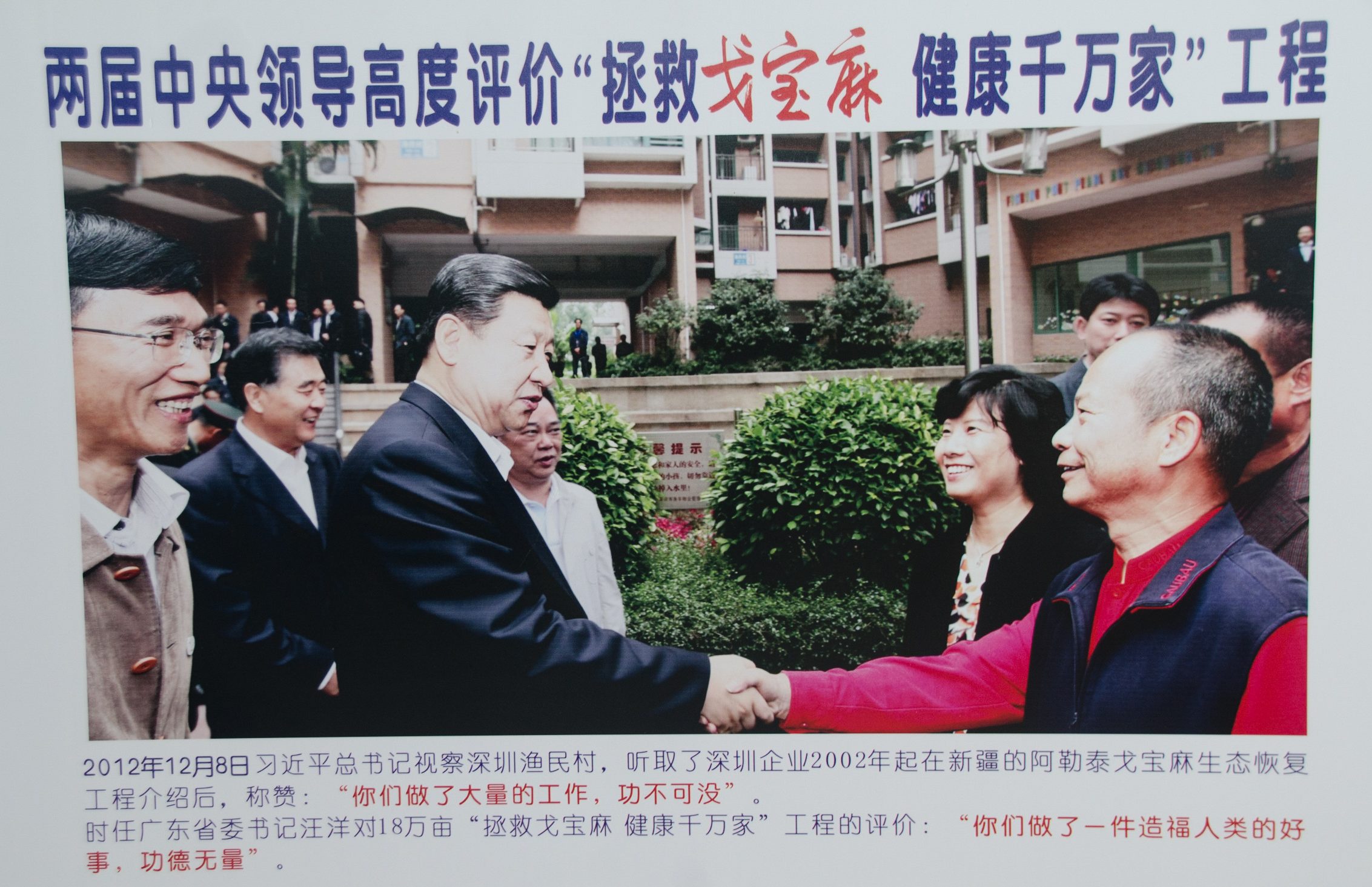 President Hu Jintao och Xi Jinping lyssnade på introduktionen av det ekologiska restaureringsprojektet av Xinjiang Altay Gebao kenaf respektive 2010 och 2012.
President Hu Jintao och Xi Jinping lyssnade på introduktionen av det ekologiska restaureringsprojektet av Xinjiang Altay Gebao kenaf respektive 2010 och 2012.
Under 2012 gav FN: s fredsambassadör, den internationella pianostjärnan Lang Lang och Gebao Group, VD Liu Qitang, baserat på det gemensamma miljöskyddskonceptet, det officiella namnet på Langlang Shenzhen Concert Hall som “Langlang Gebao Concert Hall”. Lang Lang och Ge Bao har gjort en olöslig obligation i projektet för att gynna landet och världens folk. För att stärka stödet till projektet bidrar Lang Lang, som alltid har varit oroad över miljöskydd, att bidra till att främja Gebao kenaf. Gebao varumärkesannonser kan ses på både Altay och Kanas flygplatser. Naturligtvis ger kommunen också stort stöd till detta projekt. De tror att detta inte bara förbättrar miljön utan också ökar inkomsterna hos bönder och herdar, så det är en bra sak till förmån för landet och folket.
De utländska medier som deltar i denna intervju inkluderar NHK från Japan, Green Post of Sweden, Echo News of Belgium, Tolo News of Afghanistan, Gikabar National News Agency i Kirgizistan, media i Bangladesh, NET TV i Indonesien och Indien, Egypten, Pakistan, Malaysia , Turkiet och Uzbekistan journalister. De är journalister från länder längs Silk Road Economic Belt och kommer att utforska mysterierna kring kärnområdet i Sidenväg Ekonomiska Bältets Kärnområdet–Xinjiang.
Foto och Text Xuefei Chen Axelsson
STOCKHOLM, Oct. 29(Greenpost) –On August 28th, over 30 Chinese and Foreign journalists visited the core areas of Xinjiang Silk Road Economic Belt — Burqin county in Altay City in Northern Xinjiang. The village we visit is called Tuokumut No. 1 collecting area.
According to the local official, this is an area where people can pick up the fruits themselves and buy it.
Xinjiang is famous for its various melons, honey melon, water melon and other melons which are all very sweet and delicious.
This white melon is very sweet. This is with the help of the Xinjiang Agricultural Academy’s researchers, local famers and herdmen can grow the fruits very well. It is said that they can have an income of 3000 yuan per mu. They also have farm house hotel or restaurant, or animal husbandry. All together, they can have a percapita income of 50 to 60 thousand yuan .
This is blue Gouqi Bar.
This is a free market where farmers can sell their products.
Photo and text Xuefei Chen Axelsson.
STOCKHOLM, 30 oktober (Greenpost) – Den 26 augusti och 27 blev utländska journalister inbjudna att titta på professionella föreställningar i Xinjiang Grand Theatre och Kanas Theatre för att visa Xinjiangs kultur och folklore.
Någon som är intresserad av historien har en fascination med västra regionen. “I den stora öknen kan man se solen som ligger mycket runt vattenflödet.” “Du borde inte skratta åt dem som blev berusade och föll i slagfältet. Tänk på det, hur många som kämpade i slagfältet hade kommit tillbaka? ” Den blåsa sanden, den gula sanden har täckt den gamla sidenvägen, men det kan inte dölja drömmen om att gå tillbaka till västra regionen under de senaste tusen åren längs silkesvägen.
Xinjiang Grand Theatre har hållit det stora dramatret Impression of Western Region som var ett av byggprojekten på den internationella kulturturism industriparken. Den totala investeringen var 1,76 miljarder yuan med en yta på 280 mu och en total byggyta på 100 tusen kvadratmeter. Det har listats som ett viktigt projekt under den 12: e femårsplanperioden av Xinjiang Uyghors autonoma region.
Xinjiang Grand Theatre har tagit sånger och danser i västra regionen som kärna, mot den strategiska positioneringen av Kina, Västeuropa och resten av världen. Den integrerar olika inhemska och internationella fördelaktiga kulturresurser och utforskar djärvt det nya sättet att driva och hantera den kinesiska teatern. Det högst upptagna konstpalatset har blivit det framträdande skedet av enastående konstnärer från hela världen.
Inredningsstilen för Xinjiang Grand Theatre kombinerar en mängd olika kulturer, med hjälp av rumsliga symboler i den historiska ramen inklusive Indiens Mughal-dynasti, Irans persiska imperium, Turkiets ottomanska imperium och Allawi-dynastin i Marocko. Bland dem koncentrerar sig träskärningstekniken, metallbronskonsten, snigelinsättningen, målningsprocessen, etc., på uttrycksteknikerna i den västerländska arkitekturhistorien.
På den 33 meter höga kupolhallen har dussintals noggranna målningar blivit handmålade i flera månader, vilket symboliserar väckelsen av Silkvägs vackra arkitektoniska kultur och folket omges av vackra och bländande kulturella element och övertygad av det unika hantverket.
Xinjiang Grand Theatre är för närvarande den högsta kupolstilbyggnaden i Kina. Teatern på 30 000 kvadratmeter rymmer 2 100 personer för att titta på föreställningar; Den 27 meter långa centralstationen och det 86 meter breda prestandaområdet är de största inomhusföreställningsstegen i Asien. Det finns 36 tredimensionella riktiga scener installerade i teatern. Arrangemanget är utrustad med världsledande tekniker specialdesign laser, digital vattenridå, kallt dimma vattenfall, fyrverkerier, fontäner och andra stora mekaniska scenutrustning samt multi-kanals ljudsystem och prestanda integrerat styrsystem är i allmänhet jämförbar med Operahuset i Sydney. Även inredningen av toaletten är så magnifik. Det är inte längre tillräckligt att ta bilder. Om du inte tittar på den lilla videon är det svårt att känna lyxen på Xinjiang Grand Theatre. Den är full av chock och charm. Föreställningen är cirka 130 minuter lång och är uppdelad i sex kapitel, nämligen “Big Love”, “Jade Soul”, “Dream Back to Loulan”, “Life”, “Love”, “Love of the Grassland”. ”
Under den rika nationella färgåtergivningen och den magnifika fantasinscen, isbergets fader på den mystiska sidenvägen, historien om den nationella enheten, glädjen och freden och skapandet av ett vackert hem i byggandet av den moderna civilisationen av Yaochi, och historien och kulturen i den antika västerländska musiken och dansen, Silk Road, Xinjiangs olika nationella sång- och dansstilar är organiskt integrerade för att bilda en unik och innovativ rymdutställning. “Vi skapade partiet” Återvänd till västra regionen för tusen gånger “kring det historiska och kulturella sammanhanget av Silk Road, berättar historien om en gammal mystisk Silke Road och återkommer den. De är scenerna för människor från alla etniska grupper i Xinjiang lever i harmoni på detta stora land.
Festen bestod av sex kapitel inklusive “Isbergs Fader” och “Himmelsk Skapelse”. Mer än 360 skådespelare från Georgien, Ryssland, Frankrike, Ukraina och andra länder i Guangdong, Shenzhen och Henan deltog i föreställningen. Zhou Qunsheng, regissören för “Återvänd till västra regionen för tusen gånger”, introducerade att partiet har ordentligt arrangerats i två år. För närvarande är alla aspekter av arbetet redo. Repertoaren är i nedräkningsövningen. Skådespelarna skulpterar och koncentrerar sig på musik och dans. Inomhus storskalig verklig nationell sång och dansshow, som kombinerar Silkes väg och historia med sånger och danser från olika etniska grupper i Xinjiang, har blivit ett världsklassmärke av Xinjiang sång och dans.
Kanas Theatre.
Kanas dansen om jordbruk.
Kärlek i Kanas.
Vacket klänning och scenen.
Bra spel.
These are mongolian dance and music. The costumes are also mongolian.
Beautiful clothes.
On the night of Kanas, hot air balloons are almost every night blown in front of the Grand Theatre. But it doesn’t fly to the sky, it’s just a sailing show, but it’s a real show!
Night scene of Kanas Theatre.
Night life of Kanas.
Beautiful silk jade!
Various stone souvenir!
Xinjiang poplars tree carving art!
Time is treasure, this is a fossil tree!
An unforgetable evening!
STOCKHOLM, 29 oktober (Greenpost) – Den 28 augusti besökte över 30 kinesiska och utländska journalister kärnområdena Xinjiang Silk Road Economic Belt – Burqin län i Altay City i norra Xinjiang. Byn vi besöker kallas Tuokumut nr 1 samlingsområde.
Enligt den lokala tjänstemannen är det här ett område där människor kan hämta frukterna själva och köpa den.
Xinjiang är känd för sina olika meloner, honungsmelon, vattenmelon och andra meloner som alla är mycket söta.
Den här vita melonen är väldigt söt. Detta är med hjälp av Xinjiang Agricultural Academy forskare, lokala famers och herdmen kan odla frukterna mycket bra. Det sägs att de kan ha en inkomst på 3000 yuan per mu. De har också lantgårdshotell eller restaurang eller djurhållning. Sammantaget kan de ha en inkomstinkomst på 50 till 60 tusen yuan.
Detta är blå Gouqi Bär.
Det här är en fri marknad där bönder kan sälja sina produkter.
Photo and text Xuefei Chen Axelsson.
Av Xuefei Chen Axelsson
STOCKHOLM, 29 oktober (Greenpost) – Den 28 augusti gick journalisten till Burqin County med de kinesiska och utländska journalisterna för att komma in i kärnområdet i Xinjiang Silk Road Economic Belt. Från General Mountain ner till Gebao Ma basen, sedan till den färgglada stranden. Under denna period smakade man också ett annat skyltbord på turistindustrin i Burqin County, vilket är den läckra maten parallellt med det vackra landskapet. Maten är gjord av lokala ingredienser, ren natur och original, så det smakar väldigt gott.
Chinese dumplings. Kinesiska Dumplings.
Real dumplings.
Hot chicken. Kyckling.
Pumpkin, Zhongzi och böner.
Toufu.
Xinjiang Hand-picked mutton. Lamb.
Cow stomack as a cool dish. Kos magen.
Salad.
Horse sausage, very delicious. Hästar korv.
Xinjiang food always include pepper and onion. pepper och lök.
They also like to eat a lot of garlic which is very healthy. Vitlök kyckling.
Fried dumplings! Dumpling.
Cooked fish with sugar, soysauce and vinegar. Fiskar.
Cold dish with peanut and onion. Salad.
The case is both Chinese and foreign style. Kakor.
Lamb steak! Lamb!
Black mushroom or fungas. Svamp!
Pepper is always loved by Xinjiang people all of them, Han, Hui, Ugyors and many others. Alla Xinjiang människor gillar paperika!
Foto and text av Xuefei Chen Axelsson.
By Xuefei Chen Axelsson
STOCKHOLM, Oct. 29(Greenpost)– On August 28th, the reporter went to Burqin County with the Chinese and foreign journalists to enter the core area of the Xinjiang Silk Road Economic Belt. From the General Mountain down to the Gebao Ma base, then to the colorful beach. During this period, one also tasted another signboard of the tourism industry in Burqin County, which is the delicious food in parallel to the beautiful scenery. The food is made from local ingredients, pure natural and original, so it tastes very delicious.
Chinese dumplings.
Real dumplings.
Hot chicken.
Pumpkin, Zhongzi and beans.
Toufu.
Xinjiang Hand-picked mutton.
Cow stomack as a cool dish.
Salad.
Horse sausage, very delicious.
Xinjiang food always include pepper and onion. pepper och lök.
They also like to eat a lot of garlic which is very healthy. Vitlök kyckling.
Fried dumplings! Dumpling.
Cooked fish with sugar, soysauce and vinegar. Fiskar.
Cold dish with peanut and onion. Salad.
The case is both Chinese and foreign style. Kakor.
Lamb steak! Lamb!
Black mushroom or fungas. Svamp!
Pepper is always loved by Xinjiang people all of them, Han, Hui, Ugyors and many others.
Photo and text By Xuefei Chen Axelsson.
by Xinhua writers Wang Xiuqiong, Xu Xiaoqing and Li Zhihui
SHANGHAI, Nov. 5 (Xinhua) — Chinese President Xi Jinping announced the opening of the world’s first import-themed national-level expo in Shanghai on Monday, calling it a “trail-blazing” move in the history of international trade development.
A total of 172 countries, regions and international organizations from five continents will showcase their development achievements and international image at the first China International Import Expo (CIIE).
More than 3,600 companies from different countries will hold discussions and seek common development with over 400,000 purchasers from China and overseas.
The CIIE is “a major policy for China to push for a new round of high-level opening-up and a major measure for China to take the initiative to open its market to the world,” Xi said when delivering a keynote speech at the opening ceremony.
He again underscored the role of economic globalization, saying that it is “an irreversible historical trend” and provides strong momentum for world economic development.
“All countries should be committed to opening up and oppose protectionism and unilateralism in a clear-cut stand,” Xi said, calling for joint efforts to build an open world economy.
In a time when the waves of protectionism and unilateralism are threatening global growth, the expo is expected to muster support for free trade and inject certainty to the world economy.
The fair will be the epitome of the global economy, with various quality exhibits ranging from German machine tools, Japanese robots and U.S. medical equipment to Australian wine, Brazilian farm produce and South Sudanese handicrafts.
With the slogan “New Era, Shared Future,” the expo is the brainchild of Xi and is set to become a platform for win-win economic cooperation and a landmark project in the country’s higher-level opening up.
China will stimulate the potential for increased imports, continue to broaden market access, foster a world-class business environment, explore new horizons of opening up, and promote international cooperation at multilateral and bilateral levels, Xi said.
“We are encouraged to hear from President Xi the reaffirmation of China’s support of global trade, and China’s plan to further open itself to the world,” said Robert Aspell, president of Asia Pacific for the U.S. agribusiness company Cargill, which is an exhibitor at the CIIE and has already decided to participate in the second expo.
“This is a great start of the first CIIE,” Aspell said.
The inaugural expo comes at an inflection point as China transitions to high-quality development and shifts from the world’s workshop to the world’s market, with the world’s biggest middle-income population demanding higher-quality consumer products.
Xi announced Monday China’s imported goods and services were estimated to exceed 30 trillion U.S. dollars and 10 trillion U.S. dollars, respectively, in the next 15 years. China has been the world’s second largest merchandise importer for nine consecutive years.
Joseph Boahen Aidoo, chief executive of Ghana’s cocoa industry regulator Cocoa Board, expressed hope that the fair would open a new chapter in the west African country’s cocoa exports.
“We believe that we can expand our market horizons in China. We are talking about 1.3 billion people, and even if we can get one percent of that market, it is very huge. So everybody is looking to China,” Aidoo said.
This year marks the 40th anniversary of China’s reform and opening up, and has seen a flurry of concrete measures taken by the country to open its doors wider.
“China will not close its door to the world and will only become more and more open,” Xi said.
北欧绿色邮报网北欧中华网报道(记者羊羊、陈雪霏)10月25日上午, 四川省重大项目签署仪式在芬兰首都赫尔辛基市希尔顿酒店成功举办。四川省委副书记邓小刚一行以及芬兰罗瓦涅米市市长艾斯科·罗特沃宁一行出席会议。
中芬签约仪式现场
由四川旅投、陆道原乡、芬兰乐普森集团三方共同打造的“龙泉金龙长城全龄智能运动乐园”项目,作为中芬两国合作最佳实践典范“快乐运动中国计划”的一部分,受到中芬两国社会各界的关怀与助力。四川旅投全面响应成都发展东进战略,率先启动了”快乐运动中国计划”全龄智能运动公园建设,立足龙泉驿区打造龙泉山旅游发展带,对标山地休闲运动主题区特性,打造”龙泉金龙长城全龄智能运动乐园”,大力推动龙泉驿区文旅产业转型升级发展。“龙泉金龙长城全龄智能运动乐园”的落地和建成,将助力”中国西部山地乐活运动休闲目的地”的打造,推动龙泉文旅产业核心发展区和龙泉驿区”大洛带”片区的国家级旅游度假区的创建。
未来,除了在龙泉驿区持续推动“龙泉金龙长城全龄智能运动乐园”外,四川旅投拟在郫都区唐昌镇战旗村“乡村博览园”中布局“全龄职能运动乐园”,将乡村振兴计划与习近平总书记在博鳌亚洲论坛中做出的重要指示精神——“大力发展健康事业,要做身体健康的民族”结合起来,积极探索“旅游+健康”乡村振兴创新模式,充分发挥四川旅投“三大平台”作用,推动四川由旅游资源大省向旅游经济强省跨越。
签约仪式
四川省省委副书记邓小刚见证了本次签约,在签约现场他强调,四川省正在医疗、旅游等领域深化与芬兰合作,他希望中芬双方加强人员交流互访,深化友好互利合作,拓宽合作空间,加快合作步伐,早日使两国人民共享两国交流带来的硕果。
芬兰罗瓦涅米市市长艾斯科·罗特沃宁也见证了本次签约,他表示芬兰愿意与中国建立良好的长期合作互利的伙伴关系,去年4月中国国家主席习近平对芬兰进行国事访问之后,中国对芬兰的高级别的政府间的访问和合作全面加强,今天四川代表团能够深入到旅游、医疗领域合作,说明大家对这几个领域未来的憧憬是一致的,他相信中芬经济、文化、教育等各个领域在未来一定会更加美好。
此前四川代表团“2018熊猫走世界·美丽四川”的芬兰之行正式圆满结束,“熊猫走世界”已经从北欧之旅顺利开始了,接下来还会在北欧其他国家见到可爱的四川大熊猫,让我们拭目以待。
北欧绿色邮报网主编陈雪霏
中国国际进口博览会5日在上海开幕。习近平主席出席并讲话。他说进口博览会是世界上第一个这样的博览会是中国创举。确实,在这个世界上,人们都是举行进出口交易博览会或者是出口博览会,举办进口博览会,只花钱,不挣钱,这确实是有点儿逆向思维。
但是,如果考虑中国现在所处的形势,也不难理解中国这一创举。随着中国经济迅速发展,并开始经历转型期之时,中国同世界各国的贸易,基本上都是中国顺差多,逆差少。因此,遭到很多国家的抱怨。尤其是美国对中国甚至采取大棒政策,要进一步加税,就是希望能实现贸易平衡。
中国举办进口博览会首先就是要调整中国的贸易失衡,这是中国主动为世界贸易的延续和调整采取的具体措施。
第二个原因是中国经济发展到今天,很多人有钱了,真想到世界各地去买东西,与其到外面去买,不如把卖主叫到家来,尽情地买。
第三,中国在推行一带一路倡议,例如中欧班列,往外跑卖出的多。怎么能让火车回来时也满载而归,这是中国面临的问题。因此,增加进口也是可以解决这个问题。过去是欧盟的船回欧盟很满,但是去中国很空。中国希望能改变这种情况。
第四,中国也希望能从亚非拉国家进口更多货物,从发达国家进口高科技产品,满足人们日益增长的需要。
因此,中国国际进口博览会是中国的创举,是中国想实现贸易平衡的一个重要举措,具有重要意义。